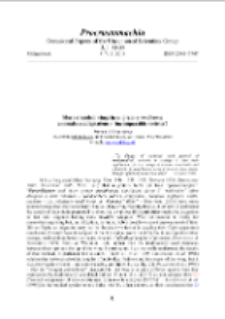
Obiekt
Tytuł: More rounded wings in migratory swallows: anomalous adaptation or incomparable metrics?
Wydawca:
Uncensored Scientists Group ; Roman Hołyński
Miejsce wydania:
Opis:
Typ obiektu:
Bibliografia:
BERTHOLD P., W. FRIEDRICH. 1979. Die Federlänge: Ein neues nützliches Flügelmaß. Vogelwarte 30, 1: 11-21
BUSSE P. 1967. Zastosowanie liczbowych współczynników kształtu skrzydła. Not. Orn. 8, 1: 1-8
BUSSE P. 1986. Wskaźniki kształtu skrzydła i problemy związane z ich interpretacją. Not. Orn. 27, 3-4: 139-155
BUSSE P. 2000. Bird station manual. Gdańsk: SEEN: 1-264
ELDREDGE N. 1989. Time frames: the evolution of punctuated equilibria. Princeton (N.J.): Princeton Univ. Press: 1-240
FRYER G. 1987. Quantitative and qualitative: numbers and reality in the study of living organisms. Freshw. Biol. 17: 177-189
GATESY J. 2007. A tenth crucial question regarding model use in phylogenetics. TREE 22, 10: 509-510
GOSLER A.G., J.J.D. GREENWOOD, J.K. BAKER, J.R. KING. 1995. A comparison of wing length and primary length as size measures for small passerines. Ringing Migr. 81: 65-78
HOŁYŃSKI R.B. 1965. Metody analizy zmienności formuły skrzydła ptaków [The methods of analysis of wing-formula variability]. Not. Orn. 6, 2: 21-25
HOŁYŃSKI R.B. 2016. Avian wing/tail morphology: interspecific relations of various indices to each other and to the distance of seasonal migration – preliminary assessment. Procrustomachia 1, 3: 24-52
HOŁYŃSKI R.B. 2017. Index of curtailment – an interesting aspect of wing formula. Procrustomachia 2, 1: 1-10
HUBER G.H., S.P. TURBEK,·K.S. BOSTWICK, R.J. SAFRAN. 2017. Comparative analysis reveals migratory swallows (Hirundinidae) have less pointed wings than residents. Biol. J. Linn. Soc. 120: 228-235
JENNI L., R. WINKLER. 1989. The feather-length of small passerines: a measurement for wing-length in live birds and museum skins. Bird Study 36: 1-15
KELLY K. 2008. Technological twist on taxonomy. Nature 452: 939
KIPP F. 1936. Studien über den Vogelzug in Zusammenhang mit Flügelbau und Mauserzyklus. Mitt. Vogelw. 35, 4-5: 49-80
KIPP F.A. 1958. Zur Geschichte des Vogelzuges auf der Grundlage der Flügelanpassungen. Vogelwarte 19, 4: 233-242
KIPP F.A. 1959. Der Handflügel-Index als flugbiologische Maß. Vogelwarte 20, 2: 77-86
ЛEВИН A.C., Э.H. ΓAВPИЛOВ, A.M. MИXAЙЛOВ. 1991. Фopмa кpылa птиц и нoвaя мeтoдикa ee изучeния. Зooл. Жуpн. 70, 3: 90-96
LOCKWOOD R., J.P. SWADDLE, J.M.V. RAYNER. 1998. Avian wingtip shape reconsidered: wingtip shape indices and morphological adaptations to migration. J. Av. Biol. 29: 273-292
MARCHETTI K., T. PRICE, A. RICHMAN. 1995. Correlates of wing morphology with foraging behavior and migration distance in the genus Phylloscopus. J. Av. Biol. 26: 177-181
MLÍKOVSKÝ J. 1978. Die Flügelformen der Vögel und ihre Auswertung. Vogelwarte 29, 4: 268-272
PILASTRO A., I. FARRONATO, G. FRACASSO. 1995. The use of feather length as a method for measuring the wing shape of passerines. Avocetta 19: 213-218
RENSCH B. 1938. Einwirkung des Klimas bei der Ausprägung von Vogelrassen, mit besonderer Berücksichtigung der Flügelform und der Eizahl. Proc. 8. Int. Orn. Cgr.: 285-311
STEGMANN B. 1962. Die verkümmerte distale Handschwinge des Vogelflügels. J. Orn. 103, 1: 50-85
UVAROV B.P. 1931. Insects and climate. Trans. Ent. Soc. Lond. 79: 1-247
Czasopismo/Seria/cykl:
Tom:
Zeszyt:
Strona pocz.:
Strona końc.:
Szczegółowy typ zasobu:
Format:
Identyfikator zasobu:
oai:rcin.org.pl:69248 ; ISSN 2543-7747
Język:
Prawa:
Licencja Creative Commons Uznanie autorstwa 3.0 Polska
Zasady wykorzystania:
Zasób chroniony prawem autorskim. [CC BY 3.0 PL] Korzystanie dozwolone zgodnie z licencją Creative Commons Uznanie autorstwa 3.0 Polska, której pełne postanowienia dostępne są pod adresem: ; -
Lokalizacja oryginału:
Biblioteka Muzeum i Instytutu Zoologii PAN
Dofinansowane ze środków:
Dostęp:
Kolekcje, do których przypisany jest obiekt:
- Repozytorium Cyfrowe Instytutów Naukowych > Kolekcje Partnerów > Muzeum i Instytut Zoologii PAN > Czasopisma
- Repozytorium Cyfrowe Instytutów Naukowych > Piśmiennictwo > Czasopisma/Artykuły
Data ostatniej modyfikacji:
6 paź 2020
Data dodania obiektu:
8 mar 2019
Liczba pobrań / odtworzeń:
126
Wszystkie dostępne wersje tego obiektu:
https://rcin.org.pl/publication/90222
Wyświetl opis w formacie RDF:
Wyświetl opis w formacie RDFa:
Wyświetl opis w formacie OAI-PMH:
| Nazwa wydania | Data |
|---|---|
| Vol. 3, no 3 (2018) | 6 paź 2020 |
Obiekty Podobne
Hołyński, Roman B.
Hołyński, Roman B.
Hołyński, Roman B.
Busse, Przemysław (1937– ) Gromadzki, Maciej (1940– ) Szulc-Olechowa, Bogumiła (1941– )
Gromadzka, Jadwiga
Kuźniak, Stanisław (1933– )
Hołyński, Roman B.

 INSTYTUT ARCHEOLOGII I ETNOLOGII POLSKIEJ AKADEMII NAUK
INSTYTUT ARCHEOLOGII I ETNOLOGII POLSKIEJ AKADEMII NAUK
 INSTYTUT BADAŃ LITERACKICH POLSKIEJ AKADEMII NAUK
INSTYTUT BADAŃ LITERACKICH POLSKIEJ AKADEMII NAUK
 INSTYTUT BADAWCZY LEŚNICTWA
INSTYTUT BADAWCZY LEŚNICTWA
 INSTYTUT BIOLOGII DOŚWIADCZALNEJ IM. MARCELEGO NENCKIEGO POLSKIEJ AKADEMII NAUK
INSTYTUT BIOLOGII DOŚWIADCZALNEJ IM. MARCELEGO NENCKIEGO POLSKIEJ AKADEMII NAUK
 INSTYTUT BIOLOGII SSAKÓW POLSKIEJ AKADEMII NAUK
INSTYTUT BIOLOGII SSAKÓW POLSKIEJ AKADEMII NAUK
 INSTYTUT CHEMII FIZYCZNEJ PAN
INSTYTUT CHEMII FIZYCZNEJ PAN
 INSTYTUT CHEMII ORGANICZNEJ PAN
INSTYTUT CHEMII ORGANICZNEJ PAN
 INSTYTUT FILOZOFII I SOCJOLOGII PAN
INSTYTUT FILOZOFII I SOCJOLOGII PAN
 INSTYTUT GEOGRAFII I PRZESTRZENNEGO ZAGOSPODAROWANIA PAN
INSTYTUT GEOGRAFII I PRZESTRZENNEGO ZAGOSPODAROWANIA PAN
 INSTYTUT HISTORII im. TADEUSZA MANTEUFFLA POLSKIEJ AKADEMII NAUK
INSTYTUT HISTORII im. TADEUSZA MANTEUFFLA POLSKIEJ AKADEMII NAUK
 INSTYTUT JĘZYKA POLSKIEGO POLSKIEJ AKADEMII NAUK
INSTYTUT JĘZYKA POLSKIEGO POLSKIEJ AKADEMII NAUK
 INSTYTUT MATEMATYCZNY PAN
INSTYTUT MATEMATYCZNY PAN
 INSTYTUT MEDYCYNY DOŚWIADCZALNEJ I KLINICZNEJ IM.MIROSŁAWA MOSSAKOWSKIEGO POLSKIEJ AKADEMII NAUK
INSTYTUT MEDYCYNY DOŚWIADCZALNEJ I KLINICZNEJ IM.MIROSŁAWA MOSSAKOWSKIEGO POLSKIEJ AKADEMII NAUK
 INSTYTUT PODSTAWOWYCH PROBLEMÓW TECHNIKI PAN
INSTYTUT PODSTAWOWYCH PROBLEMÓW TECHNIKI PAN
 INSTYTUT SLAWISTYKI PAN
INSTYTUT SLAWISTYKI PAN
 SIEĆ BADAWCZA ŁUKASIEWICZ - INSTYTUT TECHNOLOGII MATERIAŁÓW ELEKTRONICZNYCH
SIEĆ BADAWCZA ŁUKASIEWICZ - INSTYTUT TECHNOLOGII MATERIAŁÓW ELEKTRONICZNYCH
 MUZEUM I INSTYTUT ZOOLOGII POLSKIEJ AKADEMII NAUK
MUZEUM I INSTYTUT ZOOLOGII POLSKIEJ AKADEMII NAUK
 INSTYTUT BADAŃ SYSTEMOWYCH PAN
INSTYTUT BADAŃ SYSTEMOWYCH PAN
 INSTYTUT BOTANIKI IM. WŁADYSŁAWA SZAFERA POLSKIEJ AKADEMII NAUK
INSTYTUT BOTANIKI IM. WŁADYSŁAWA SZAFERA POLSKIEJ AKADEMII NAUK


































